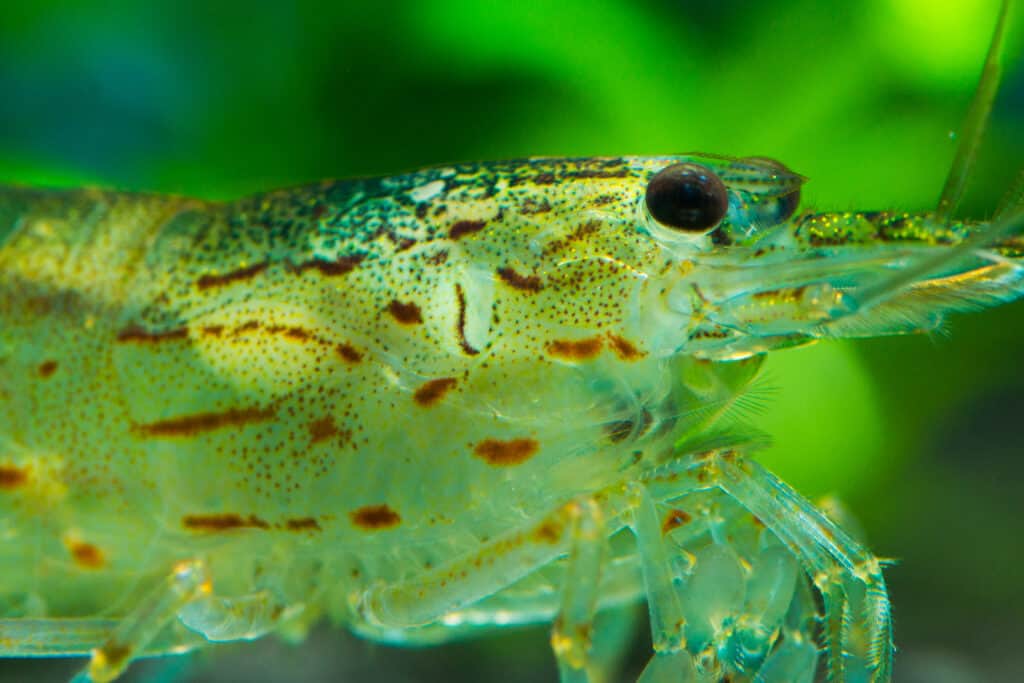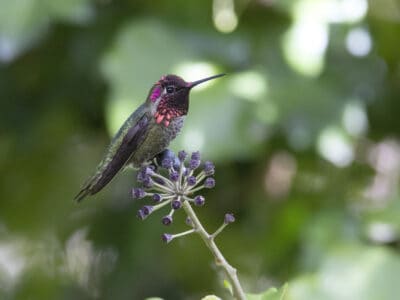Amano Shrimp
Caridina multidentata
Popular kept in aquariums to keep them clean
Advertisement
Amano Shrimp Scientific Classification
- Kingdom
- Animalia
- Phylum
- Arthropoda
- Class
- Malacostraca
- Order
- Decapoda
- Family
- Atyidae
- Genus
- Caridina
- Scientific Name
- Caridina multidentata
Read our Complete Guide to Classification of Animals.
Amano Shrimp Conservation Status
Amano Shrimp Facts
- Prey
- Insects
- Name Of Young
- Larvae
- Group Behavior
- Solitary
- Fun Fact
- Popular kept in aquariums to keep them clean
- Biggest Threat
- Predators
- Most Distinctive Feature
- Row of dark spots along the sides
- Distinctive Feature
- Born in freshwater but develop in brackish water
- Other Name(s)
- Japanese shrimp, Yamato shrimp, algae shrimp
- Optimum pH Level
- 6.5-7.5
- Incubation Period
- 7 weeks
- Age Of Independence
- Immediately after hatching
- Average Spawn Size
- 1,000
- Habitat
- Freshwater and brackish water
- Predators
- Fish, birds, lizards, frogs, other shrimp
- Diet
- Omnivore
- Lifestyle
- Diurnal
- Solitary
- Favorite Food
- Algae
- Common Name
- Amano shrimp
- Special Features
- Relentless consume algae
- Number Of Species
- 1
- Location
- Japan and Taiwan
- Age of Molting
- Around once per month
View all of the Amano Shrimp images!
Summary
Popular in the aquarium trade, the Amano shrimp goes by many names, including the Yamato shrimp, Japanese shrimp, and algae shrimp. Native to Taiwan and Japan, they primarily feed on algae, hence their name. While they are born in freshwater, the larvae drift out to sea to develop before returning to freshwater as adults. They are very difficult to breed in captivity, so many kept in aquariums were once wild.
5 Amano Shrimp Facts
- Professional cyclist, designer, and aquarist Takashi Amano first made Amano shrimp popular in the early 1980s.
- They primarily feed on algae and algae supplements but also enjoy animal-based protein such as daphnia or mysis.
- The average lifespan of a healthy Amano shrimp is about 2 to 3 years, but they can easily die young due to stress or other environmental factors.
- They are born in freshwater but require saltwater to grow and develop.
- Like other crustaceans, Amano shrimp molt their exoskeletons and often eat the old exoskeleton to replenish minerals.
Amano Shrimp Classification and Scientific Name
The Amano shrimp belongs to the tropical and temperate freshwater shrimp family Atyidae. They also go by the names the Yamato shrimp and Japanese shrimp because they are native to Japan. Some people also refer to it as the algae shrimp because its diet primarily consists of algae. They belong to the genus Caridina, which contains around 300 different distinct species. Its full scientific name is Caridina multidentata. The word multidentata derives from the Latin words multi, meaning “many,” and dentata, meaning “toothed.”
Amano Shrimp Appearance

They appear almost translucent but have a gray or greenish hue. A white stripe runs the length of the back from the head to the tail.
©DavidTing/Shutterstock.com
At their largest, Amano shrimp can grow up to 2 inches long, making them one of the larger species of dwarf shrimp kept in aquariums. They appear almost translucent but have a gray or greenish hue. A white stripe runs the length of the back from the head to the tail. In addition, they feature a dark line of dots that runs down either side of their body. These dots can look either reddish-brown or gray-blue, depending on their diet. Generally speaking, the more algae they eat, the more the dots take on a blue-green hue. You can often distinguish females from males by their more elongated row of lower dots. Their color acts as a form of camouflage that helps them to blend in with their environment and avoid predators.
Amano Shrimp Distribution, Population, and Habitat
Historically speaking, they are native to freshwater habitats in Japan and Taiwan. While they originated in east Asia, today you can find Amano shrimp in aquariums all over the world. They can live in both temperate and tropical water and fare best in temperatures between 18 and 28 degrees Celsius. That said, shrimp that live in slightly cooler water tend to live longer than shrimp that live in warmer water. They require a relatively neutral water pH rating of 6.5 to 7.5 and cannot tolerate water with a high copper level. However, they can tolerate relatively hard water. They do best within a slow or medium-strength current, as they don’t particularly like fast-moving water.
Amano Shrimp Predators and Prey
In the wild, Amano shrimp must contend with a wide variety of predators. Some common predators of them include various species of freshwater fish, including cod, trout, bass, and catfish. In addition, they are also eaten by frogs, lizards, and birds. As pets, they are often preyed upon by goldfish, bettas, and Oscars, and as such, should be kept away from these larger predatory fish. Larger shellfish like crayfish or freshwater lobsters and pet amphibians like African dwarf frogs may also prey on Amano shrimp.
Algae make up the bulk of an Amano shrimp’s diet. Compared to other aquarium shrimp, they will obsessively seek out algae wherever it accumulates in a tank and swarm over food. While algae make up the bulk of their diet, Amano shrimp are opportunistic omnivores that require a balanced diet to thrive. In the wild, they eat phytoplankton, detritus, carrion, and tiny insects. As pets, they primarily subsist on the algae that accumulate in their tank as the result of leftover food particles, bacteria accumulation, and decaying plant matter. They enjoy algae wafers and spirulina flakes as well as popular aquarium features like moss balls and sponge filters. Many people also choose to feed them animal protein such as daphnia, mysis, bloodworms, or brine shrimp.
Amano Shrimp Reproduction and Lifespan
During the breeding season, females release pheromones into the water to attract male mates. They breed in freshwater rivers, streams, and marshes, particularly in cooler water. On average, it takes about 7 weeks for a female’s eggs to fully mature. The eggs start out a light green color and gradually shift to yellowish-brown. Females can spawn up to 1,000 eggs at a time. When the larvae hatch in the wild, they naturally drift out toward brackish saltwater habitats. The larvae remain in saltwater while they develop until they reach sexual maturity, returning to freshwater to breed and live out the remainder of their lives. Like other shrimp, they shed their exoskeletons throughout their lives as they grow. Typically, the average shrimp will shed its exoskeleton around once per month. Given the right conditions, a healthy Amano shrimp can live up to 2 to 3 years in captivity.
It’s a known fact that they are notoriously difficult to breed in captivity. The females require the right conditions to breed and for their eggs to fertilize their eggs. While mating, they require cooler water, but once the eggs fertilize, they typically prefer warmer water. Water temperature needs to increase slowly so as not to stress out the shrimp. Additionally, warmer water increases the female’s metabolism, which means they require more food. Once the eggs hatch, the larvae must be transferred to brackish water to mature. The salinity must be kept within optimal ranges for the larvae to mature. Given the fact that breeding Amano shrimp is so difficult, many kept in aquariums were caught in the wild.
Amano Shrimp in Food and Cooking
Presently, Amano shrimp are not known for their use in food and cooking. While you could eat them if necessary, their small size means that they aren’t a viable target for commercial fishing. Instead, Amano shrimp are primarily caught for the pet trade. They make great natural tank cleaners thanks to their voracious appetite for algae.
Amano Shrimp Population
Prior to the 1980s, Amano shrimp were largely ignored by the pet industry. Thanks to the influence of individuals like Takashi Amano, they have since become one of the most popular shrimp kept in aquariums thanks to their ability to keep tanks clean. However, Amano shrimp are very difficult to breed in captivity because they require a saltwater environment to develop from juveniles into adults. As a result, most Amano shrimp raised as pets started life in the wild. Despite increased harvesting for the pet trade, wild Amano shrimp populations don’t appear to be unduly affected or are not showing signs of decline. Currently, the IUCN lists the Amano shrimp as a species of Least Concern.
Related Animals
View all 194 animals that start with AAmano Shrimp FAQs (Frequently Asked Questions)
Are Amano shrimp carnivores, herbivores, or omnivores?
Amano shrimp are opportunistic omnivores that primarily feed on algae but will also eat animal protein such as daphnia and mysis.
Where are Amano shrimp found?
You can find Amano shrimp throughout tropical and temperate freshwater systems in Japan and Taiwan.
How many Amano shrimp can you keep together?
To maintain a clean aquarium, you should keep at least 1 Amano shrimp per 15 liters of water. However, you can bump that up to 1 shrimp per 5 liters of water.
Are Amano shrimp hard to keep?
Generally speaking, Amano shrimp are easy to keep and care for. However, they can prove difficult to breed in captivity and can die from too much stress.
Thank you for reading! Have some feedback for us? Contact the AZ Animals editorial team.
Sources
- Practical Fish Keeping, Available here: https://www.practicalfishkeeping.co.uk/features/articles/amano-shrimp-spineless-heroes
- Practical Fish Keeping, Available here: https://web.archive.org/web/20090212172341/http://www.practicalfishkeeping.co.uk/pfk/pages/item.php?news=1078

















